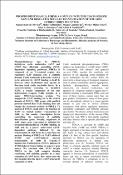Options
Phosphodiesterase 2A forms a complex with the co-chaperone XAP2 and regulates nuclear translocation of the aryl hydrocarbon receptor
Alternative Title
PDE2A interacts with XAP2
Date Issued
2007-05-04
Date Available
2014-09-16T08:54:29Z
Abstract
Phosphodiesterase type 2A (PDE2A) hydrolyzes cyclic nucleotides cAMP and cGMP, thus efficiently controlling cNMP-dependent signaling pathways. PDE2A is composed of an amino-terminal region, two regulatory GAF domains, and a catalytic domain. Cyclic nucleotide hydrolysis is known to be activated by cGMP binding to GAF-B; however, other mechanisms may operate to fine-tune local cyclic nucleotide levels. In a yeast two-hybrid screening we identified XAP2, a crucial component of the aryl hydrocarbon receptor (AhR) complex, as a major PDE2A-interacting protein. We mapped the XAP2 binding site to the GAF-B domain of PDE2A. PDE assays with purified proteins showed that XAP2 binding does not change the enzymatic activity of PDE2A. To analyze whether PDE2A could affect the function of XAP2, we studied nuclear translocation of AhR, i.e. the master transcription factor controlling the expression of multiple detoxification genes. Notably, regulation of AhR target gene expression is initiated by tetrachlorodibenzodioxin (TCDD) binding to AhR and by a poorly understood cAMP-dependent pathway followed by the translocation of AhR from the cytosol into the nucleus. Binding of PDE2A to XAP2 inhibited TCDD- and cAMP-induced nuclear translocation of AhR in Hepa1c1c7 hepatocytes. Furthermore, PDE2A attenuated TCDD-induced transcription in reporter gene assays. We conclude that XAP2 targets PDE2A to the AhR complex, thereby restricting AhR mobility, possibly by a local reduction of cAMP levels. Our results provide first insights into the elusive cAMP-dependent regulation of AhR.
Other Sponsorship
Deutsche Forschungsgemeinschaft
Type of Material
Journal Article
Publisher
American Society for Biochemistry and Molecular Biology
Journal
Journal of Biological Chemistry
Volume
282
Issue
18
Start Page
13656
End Page
13663
Copyright (Published Version)
2007 American Society for Biochemistry and Molecular Biology
Language
English
Status of Item
Peer reviewed
This item is made available under a Creative Commons License
File(s)
Loading...
Name
PDE-XAP2_20.pdf
Size
4.06 MB
Format
Adobe PDF
Checksum (MD5)
38f30add0ecc05707eeda5a678003fa6
Owning collection